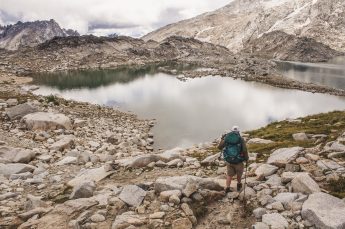Introduction
Quick Navigation
It does not matter if you are backpacking for a weekend or an extended period; you need to wear layered clothing based on the weather conditions. When it comes to knowing what to wear for backpacking, you must realize that wearing layered clothing is key. If you begin to sweat, you can always take one off, and when you start to feel cold, you can put another layer on. The clothing choices to make when you go backpacking have to do with functionality, weight, and comfort. That means you will want to wear clothing that dries quickly and is moisture-wicking, as well as having antimicrobial properties, and will protect you from the sun, insects, and other nuisances. Another thing to consider when choosing to clothe for backpacking is how different features such as hoods, zippers, pockets, and others affect you. Let’s now go over the basics of clothing fabrics for backpacking.
Fabric Basics For Backpacking
When you choose to clothe for backpacking, you want to know about the type of fabrics they consist of, which will also influence your clothing choices. One excellent fabric to use for clothing is wool. It has had the reputation of being too itchy and uncomfortable, but you want to look for ultra-fine merino wool because it does not cause itching. This fabric is ideal because it dries quickly, is moisture-wicking, and is breathable. Additionally, it is not prone to foul odors. Wool can make awesome tees, socks, base layers, and hats. However, some people avoid it since it is difficult for sensitive skin and can be costly again.
Another popular form of fabric is clothing made from nylon or polyester. The reason for that is that this fabric is durable and dries quite fast. Therefore, if you want to get shirts and pants, this is the fabric you wish them to consist of because of these reasons. The only thing is that some people do not like nylon or polyester because they are not odor-free and can feel somewhat clammy, unlike wool.
Some hikers and backpackers wear clothing that consists of silk, and the reason for that is that it is comfortable, soft, and does not add any weight. And new silk clothing can wick moisture. However, like nylon, silk can be prone to absorbing odors, and sunlight can also erode it. So it is a good fabric for backpacking in cool weather.
Another fabric some backpackers like is cotton because it is comfortable. However, it is not an option that experienced backpackers recommend. That is because cotton does not wick moisture and does not insulate you very well, and it also takes a very long time to dry. However, if you want to lounge around in your tent, you can wear cotton. But backpacking is not a good idea. So now, let’s talk about how you can layer yourself.
Layers Of Clothing For Backpacking
You wear layers of clothing wherever you go, such as underwear, pants, shirts, socks, and hats if sunny or cold outside. However, when you are backpacking, the type of fabrics to wear is essential to know so you can stay dry, comfortable and lower your chances of maintaining odors. Let’s talk about underwear to start.
Some men like to have boxers, and women want short-cut underwear. However, it is essential not to wear cotton underwear because they will not get dry and uncomfortable to wear. Manufacturers of wool underwear make them comfortable to wear, and many backpackers like that. Some backpackers wear spandex or nylon underwear. And it is best to take two to three pairs of underwear per day when going on heavy backpacking excursions. For women, backpackers also have to worry about what bras to wear.
Bras that you can pull over that do not have clasps are the best types as there are plenty of sports bras like that. Bras consisting of silk or synthetic fabrics such as polyester or nylon are also popular among female backpackers. Men and women also want to wear tank tops as they are lighter than T-shirts as the best types consist of fine wool, silk, polyester, or nylon. The same goes for base layers or bottoms such as longjohns, and you want to make sure that they are breathable, so you are comfortable. Zip-necks and crew necks will provide you with the ventilation you need, and they are best to keep you warm when you are backpacking in colder conditions. What about your pants, shirts, or shorts?
You will want to bring one long-sleeve shirt, two T-shirts, and a pair of synthetic and lightweight pants. Stick with the polyester or nylon, or wool T-shirt, and wool long-sleeve shirts should also have the same fabrics to help repel UV rays, insects and to keep you warm. If it is very cool, you can also wear fleece tops to keep you warm. For freezing days, wear a vest or a jacket that is puffy and insulated. Softshell jackets are also a good idea as they consist of fleece lining and are ideal for freezing temperatures.
You will also want to have pants that have zippers, and roll-up pants are popular but make sure that the pants you wear do not have zippers that can irritate your skin. Most consist of synthetic fabrics, and it is best to avoid yoga pants.
Don’t forget to take ample wool socks, hats, gloves to keep you warm, and gloves to protect you from the sun. You can also wear a cotton bandana (the only time cotton is okay) to wear on your head so that you keep hair out of your eyes or wear it around your neck for protection.
Conclusion
When you are backpacking‘, the one thing to plan is your clothing. You will want to ensure you wear clothing consisting of specific fabrics that will wick moisture, dry quickly, repel the sun and insects, and stay free of odors. And you want to be comfortable, which is the most important thing. However, cotton is not a good idea as it does not dry quickly, and it does not repel odors. Fabric such as silk, wool, and synthetic materials such as polyester and nylon are the best fabrics for backpacking. You can always speak to experienced backpackers to learn what works for them.

